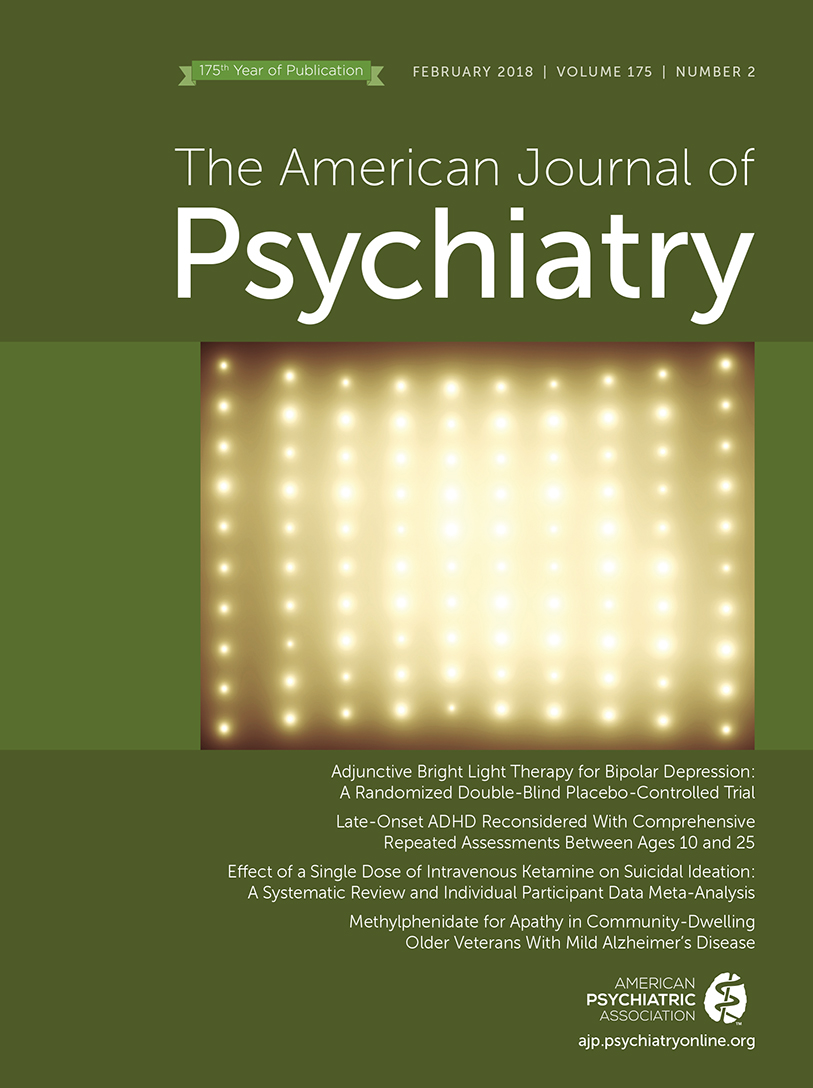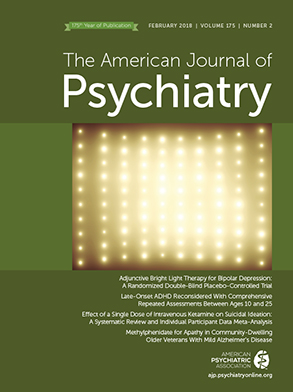Concepts of attention deficit hyperactivity disorder (ADHD) in adulthood have changed greatly. Initially, it was held that ADHD both began and, essentially, ended in childhood. However, in the 1990s a series of prospective studies showed that around 15%−20% of children will continue to show the full syndrome into adulthood, and symptoms of inattention persist in a further 50% (
1). Most recently, a series of studies found that the syndrome could have its onset in adolescence, or even adulthood—herein referred to as late-onset ADHD—challenging the accepted view of ADHD as a neurodevelopmental disorder with an invariable childhood onset (
2–
4).
In this issue of the
Journal, Sibley et al. (
5) further examine adolescent and adult presentations of ADHD. They leveraged data from a group of children initially without ADHD who served as a comparison group in a well-known ADHD treatment study (the Multimodal Treatment Study of ADHD). This childhood cohort had repeated, detailed clinical assessments into early adulthood. The key finding was that 40% of these participants during adolescence and 20% during adulthood screened positive for ADHD on a symptom checklist that was not dissimilar from several assessment measures in popular use. However, this startling prevalence of apparent late-onset ADHD (i.e., with an onset after the
DSM-5 cut-off age of 12) plummeted to 3.3% as soon as three sensible constraints were implemented. First, it was ensured that the symptoms caused impairment across multiple contexts. Second, the symptoms were not better explained by substance misuse or another mental disorder. Finally, the exact chronology of symptom course was mapped to ensure that the onset was indeed after age 12. The prevalence of late-onset ADHD fell further to 2% if those with childhood symptoms that fell near the diagnostic threshold were excluded, suggesting that their ADHD was as much late-recognized as late-onset.
The study has two important contexts. First, as a cursory glance of the Internet or any magazine rack will show, there exists a vast number of “questionnaires for ADHD.” The Sibley et al. study is a telling demonstration of the likely lack of positive predictive power of such “diagnosis by checklist”: only 9% of those who screened positive for late-onset ADHD met the stringent criteria for a diagnosis. Screening tools can be valuable but do not substitute for in-depth assessments by a well-trained team, particularly when trying to establish a new diagnostic entity.
The second context is a recent set of birth cohort studies, mentioned above, suggesting firstly that ADHD can have an adolescent or adult onset and, secondly, that among adults with ADHD, a late onset is more common than a childhood onset (
2–
4). At first glance, these findings seem at odds with those from the study by Sibley et al., which in essence argue that many cases of late-onset ADHD are illusory, stemming from a lack of consideration of impairment, symptom chronology, and mental health history.
Before considering the differences between the birth cohort studies and the Sibley et al. study, it is worthwhile noting several points of agreement. First, while the Sibley et al. study highlights the potential pitfalls in diagnosing late-onset ADHD, it nonetheless returns a prevalence of late-onset ADHD of between 2% and 3.3%. This prevalence estimate is similar to the 2.7% prevalence of adult-onset ADHD reported in the Dunedin birth cohort study conducted in New Zealand, which followed participants into middle age (
2). A prevalence of 2%−3% is far from trivial, even if the late-onset syndrome frequently arises in the context of complex psychopathology, as suggested by Sibley et al. However, notable differences emerge when we consider the two birth cohorts that covered a similar age range as that analyzed in the Sibley et al. study (
3,
4). These birth cohorts returned prevalence estimates of late-onset ADHD of 5.5% (in the Environmental Risk Longitudinal Twin Study conducted in the United Kingdom [
3]) and 12.2% (in the Pelotas Birth Cohort Study conducted in Pelotas, Brazil [
4]), substantially higher than the Sibley et al. estimate. Although the birth cohort prevalence estimates fall when substance misuse and other mental disorders are considered (for example, to 6.3% in the Pelotas, Brazil study), exploring additional possible reasons for the variable prevalence estimates is still worthwhile, since all the studies were well-designed and meticulously conducted.
The first difference worth noting is that the studies used different sampling strategies. The Sibley et al. study cohort comprised the initially unaffected, same-sex classroom peers of a childhood ADHD group. As a result, this cohort had a male preponderance, as childhood ADHD is more common in boys. This may be relevant, since late-onset ADHD has been found to have either a balanced sex distribution or a female preponderance (
2–
4). Thus, the selection criteria in the Sibley et al. study may have introduced a factor that requires adjustments before extrapolation is made to the general population. By contrast, the birth cohorts allow more direct statements to be made about likely general population prevalence. The studies also differ in scale: while the Sibley et al. study had a cohort of several hundred, the population cohorts were in the thousands. While size alone is no guarantee of validity, larger samples allow the precision of the estimated prevalence and risk of late-onset ADHD to be calculated (
3).
Another key difference is how the diagnoses of childhood and late-onset ADHD were made in each study. The Sibley et al. study had the great strength of using both parents and participants consistently as informants from childhood into adulthood. However, in the birth cohort studies, the finding of late-onset ADHD was sometimes accompanied by a change in the main source of diagnostic information, a feature that has been highlighted elsewhere (
6). For example, in the Environmental Risk Longitudinal Twin Study, the childhood diagnosis was made through an interview with the mother and a teacher-completed questionnaire, whereas the adult diagnosis was through an interview with the participant alone (although co-informant questionnaire data were obtained). A lack of agreement in ADHD symptoms across different classes of raters—patients, parents, teachers, and clinicians—is well recognized, particularly in adulthood, and could contribute to the difference in prevalence estimates (
7,
8).
Finally, while all the studies showed considerable depth of assessment, there were still differences. For example, in the Sibley et al. study, several key decisions were made by a team of highly trained clinicians who reviewed a swathe of multi-informant data. The study includes clinical vignettes and detailed symptom trajectory maps that provide a compelling rationale for these complex decisions. This depth of assessment is less feasible in cohort studies that have sample sizes in the thousands, and this methodological difference could also contribute to the variable prevalence estimates.
It is premature to make definitive conclusions, but three initial impressions are warranted. First, there appears to be a nontrivial incidence of late-onset, impairing ADHD that is not better explained by another mental disorder or substance misuse. The minimum current estimate is around 2%−3%. Even if this late-onset syndrome is mostly confined to adolescence and even if it often occurs in the context of other comorbidities, as suggested in the Sibley et al. study, ADHD is often a highly treatable target.
Secondly, methods matter. For example, here it is speculated that by undersampling females, the incidence of late-onset ADHD might have been underestimated in the Sibley et al. study, whereas changes in primary informants over time in the birth cohort studies might have led to an overestimation. Of course, even if these speculations are correct, it is still hard to reconcile fully the wide-ranging prevalence estimates. This prompts a call for future research into a potentially major public health challenge, and it draws a welcome focus onto young adults presenting to services for the first time with symptoms of ADHD. There are many possible scenarios that warrant consideration. For example, it is possible that quiet, nondisruptive but inattentive girls are being overlooked in childhood, particularly when they have a higher than average IQ and can perform reasonably well at school. When these women, rather than parents and teachers, become the primary informant at age 18, they declare their history of inattention, which may have become more impairing in less structured adult settings. This scenario might explain the female preponderance of late-onset ADHD, its association with intact executive function and high IQ, and perhaps some of the substance misuse, if these females turn to substances for self-medication or in frustration.
Finally, there is a clinically important consensus across these studies. All hold that symptoms of inattention, hyperactivity, and impulsivity presenting de novo in adolescence or adulthood can be highly impairing and thus cannot be ignored due to uncertainty over their nosology. As we assess patients, the Sibley et al. study reminds us of the importance of obtaining collateral information and the need to place emerging symptoms of ADHD in the context of a lifetime history of psychopathology.

